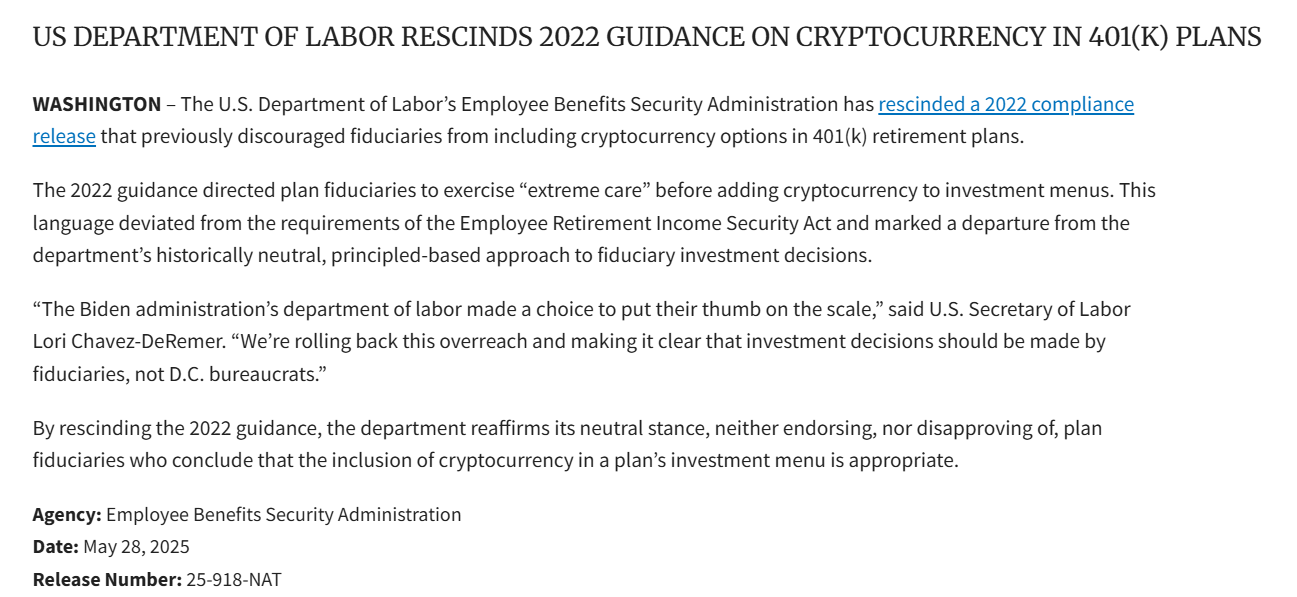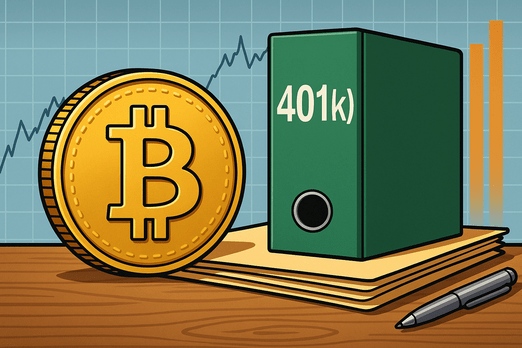The US Labor Department on May 28, 2025, officially rescinded its 2022 guidance that discouraged the use of cryptocurrency in 401(k) plans.
The move now gives fiduciaries the authority to decide if they want to include crypto investment options in retirement accounts.

The 2022 policy had advised fiduciaries to show “extreme care” before offering digital assets to plan participants. It raised concerns about volatility, valuation, and the speculative nature of cryptocurrencies. The rule did not ban crypto, but it limited its adoption across employer-sponsored retirement plans.
Labor Secretary Lori Chavez-DeRemer confirmed the reversal and stated:
“We’re rolling back this overreach and making it clear that investment decisions should be made by fiduciaries, not D.C. bureaucrats.”
The new decision returns investment control to plan managers, following what the Department called a “neutral, principled-based approach” to fiduciary decisions.
Crypto Investment Options May Expand in Retirement Plans
With the previous 401(k) crypto guidance revoked, plan sponsors and asset managers are now free to evaluate and offer cryptocurrency investment options if they meet fiduciary requirements.
Back in 2022, the American Banking Association (ABA) criticized the Labor Department’s guidance, saying it had been issued without public review or comment.
The ABA pointed out that the guidance set an unusual precedent by warning against a specific asset class without allowing proper input from financial professionals.
The guidance also discouraged providers from marketing cryptocurrencies to retirement plan users, citing risk to savings, custody challenges, and regulatory uncertainty.
Even without a formal ban, this led most plan providers to avoid crypto-related offerings.
The latest update removes that warning and could result in wider acceptance of crypto in retirement portfolios, depending on each provider’s internal policy.
Trump Administration Backs Crypto Access in 401(k) Plans
This change reflects a broader shift under the Trump administration, which has promised to make the United States a global hub for digital assets.
During his 2024 campaign, Donald Trump supported policies to grow the crypto sector and limit federal enforcement actions.
The Securities and Exchange Commission (SEC) has since scaled back actions against major firms in the Web3 space, including Uniswap, Coinbase, and Kraken.
Regulatory discussions are ongoing about real-world asset tokenization, stablecoin regulations, and the classification of crypto tokens.
The rollback of the 401(k) crypto guidance aligns with that deregulatory trend. The administration has stated that fiduciaries should have the freedom to assess all asset types without federal interference.
Some lawmakers have responded with concern about Trump’s ties to crypto projects and his influence on federal policy. However, no formal restrictions have been proposed.
Providers Like Fidelity Already Offer Crypto Retirement Products
Before the 2022 policy, Fidelity Investments had launched 401(k) accounts with crypto access, offering Bitcoin investment options at low fees.
That move triggered warnings from the Labor Department but stayed in place with limited adoption.
Now, with the crypto in 401(k) plans restriction lifted, providers could expand their offerings again.
Each plan sponsor will still need to follow fiduciary duty rules under the Employee Retirement Income Security Act (ERISA), ensuring that crypto investments meet risk and suitability standards.
The Labor Department has not issued new specific rules on crypto but confirmed that it will maintain a neutral stance.
This means cryptocurrency retirement investments will be treated like any other investment, subject to the same due diligence requirements.
The change could affect how digital assets are included in long-term retirement strategies, depending on each provider’s assessment.
Disclosure:This article does not contain investment advice or recommendations. Every investment and trading move involves risk, and readers should conduct their own research when making a decision.
Kriptoworld.com accepts no liability for any errors in the articles or for any financial loss resulting from incorrect information.


